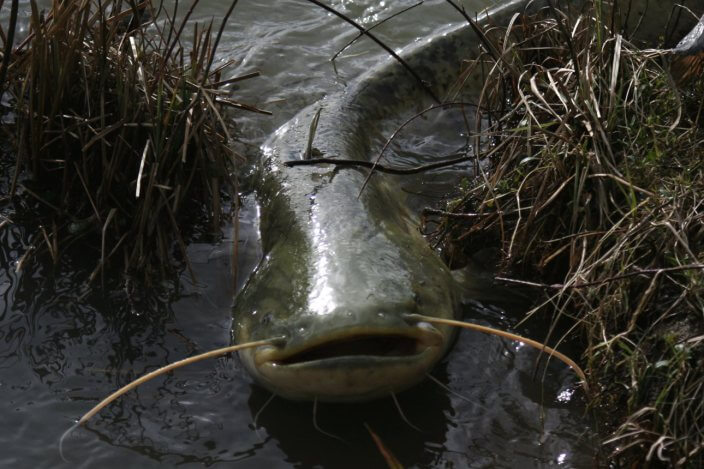Catfish jump ashore to hunt doves
Yonat Ashhar and Noam Levithan Galileo

Imagine you are a fish. Not just any fish - catfish, a fairly large fish, one meter to one and a half meters long. In the stream where you live there are many more catfish, perhaps a little too many, because it is difficult for you, lately, to find your favorite prey - small fish or crabs. There are, however, other animals that come to the stream, or at least to the shallow water on its shore - pigeons. They usually gather on a small island in the stream and bathe in its waters. If only you could jump out of the water and reach them...
It seems that some enterprising European catfish (Silurus glanis) have learned to do just that. Julien Cucherousset and other researchers from universities in Toulouse, France studied a local population of catfish, in a small river near the city of Albi. The researchers reported in PLOS ONE magazine about the unusual behavior of these catfish - they were repeatedly observed swimming near the shore, then "throw" themselves on the bank, so that a significant part of their body is outside the water (an action called beaching). They always landed among a group of pigeons that had come to bathe, when they tried to grab one of them and drag it into the water. 54 times the researchers saw a catfish perform this strange activity - and in 15 of them the fish succeeded in hunting a pigeon.
This is not the first case in which an aquatic predator has been observed "going ashore" to hunt land prey. Orcas (killer whales) are especially known for this - they usually jump out of the water and kidnap sea lions from the beach. But this is probably the first time that fish (and not marine mammals) have developed such a sophisticated hunting method.
It is interesting to note that the Balbi river is not the catfish's natural habitat - they originate in Eastern Europe and were brought to this part of France about 30 years ago. Such a hunting method was never observed in the original catfish populations. The researchers speculate that the conditions in the new habitat may be less ideal for the catfish (it is possible, for example, that the stream does not have enough of the catfish's "classic" prey, fish and crabs) and therefore they are forced to go out of their way, literally, in search of more hunting.
Even within Albi's population, not all catfish engage in pigeon hunting. The isotope carbon-13 ("heavy carbon") is more common in birds than in fish and crabs, and by analyzing the amounts of the isotope in the caught catfish, the researchers were able to conclude how important the pigeon meat was to a certain individual's diet. They discovered that there was great diversity among the fish - some relied on pigeon hunting to a great extent, and some hardly or not at all. Perhaps contrary to what one might expect, the fish pigeons hunted were not the largest, but rather tended to be smaller than average. It is possible that intense competition for the fish in the stream, where the larger catfish usually win, has led the small catfish to find their own niche.
It is not known how the fish developed their special hunting method, and whether there was a "genius fish" who invented it and the others learned from him, or whether all the hunters discovered how to hunt pigeons on their own. The fact that this behavior appears (as far as we know) only in one population, but in this population it is quite common, may imply that it is learned in a social way - one individual learns from the other. Such behaviors, which are not "instincts" but depend on the ability to observe and imitate and perhaps also require a degree of understanding, are not usually attributed to animals we perceive as "primitive", such as fish. But more and more studies indicate that we may be underestimating our gilled relatives.
In order to know if there really is a learned behavior here and if we should start getting used to the idea of fish with a hunting tradition, more studies should be conducted, in which the researchers will be able to identify certain individuals that participate (or not) in the hunt, and trace the way in which they learn to do so. The study by Kashousa and his colleagues describes the phenomenon - the studies that will come in the future will try to explain it.
The original article:
Cucherousset, J. et al. "Freshwater Killer Whales": Beaching Behavior of an Alien Fish to Hunt Land Birds. PLoS ONE 7, e50840 (2012). doi: 10.1371 / journal.pone.0050840

2 תגובות
: )
By Yonat Ashchar and Noam Levitan
just say'n